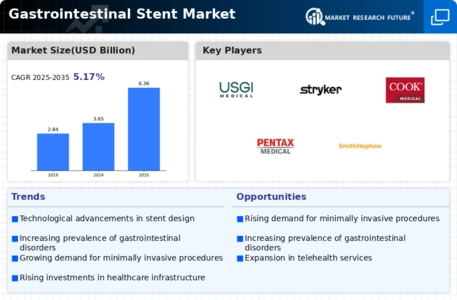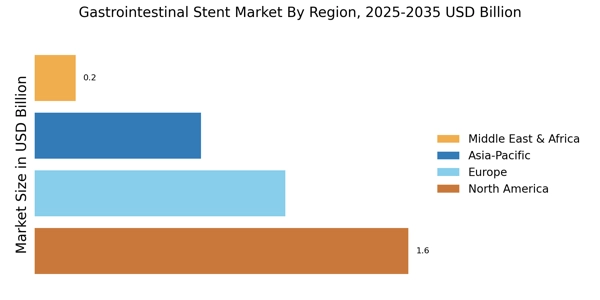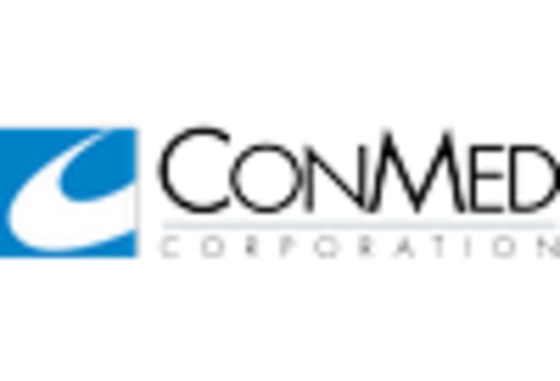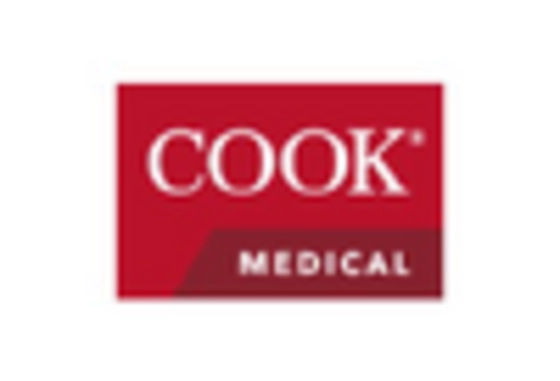Technological Advancements in Stent Design
The Gastrointestinal Stent Market is experiencing a notable transformation due to rapid technological advancements in stent design and materials. Innovations such as biodegradable stents and drug-eluting stents are gaining traction, enhancing patient outcomes and reducing complications. The introduction of advanced imaging techniques and minimally invasive deployment methods is also contributing to improved procedural success rates. As a result, the market is projected to witness a compound annual growth rate of approximately 6.5% over the next few years. These advancements not only improve the efficacy of stents but also expand their applications across various gastrointestinal disorders, thereby driving the overall growth of the Gastrointestinal Stent Market.
Shift Towards Minimally Invasive Procedures
There is a discernible shift towards minimally invasive procedures within the Gastrointestinal Stent Market, driven by patient preference for less traumatic treatment options. Minimally invasive techniques offer numerous advantages, including reduced recovery times, lower risk of complications, and shorter hospital stays. As healthcare systems increasingly prioritize patient-centered care, the demand for stenting procedures that align with these principles is on the rise. This trend is supported by advancements in endoscopic techniques and tools, which facilitate the placement of stents with greater precision. Consequently, the Gastrointestinal Stent Market is likely to expand as more healthcare providers adopt these innovative approaches to treatment.
Regulatory Support and Reimbursement Policies
Regulatory support and favorable reimbursement policies are pivotal in shaping the Gastrointestinal Stent Market. Governments and health authorities are increasingly recognizing the importance of gastrointestinal stenting as a viable treatment option, leading to streamlined approval processes for new stent technologies. Additionally, favorable reimbursement frameworks are encouraging healthcare providers to adopt these interventions more widely. As reimbursement policies evolve to cover a broader range of stenting procedures, the market is likely to see increased adoption rates. This supportive regulatory environment is expected to foster innovation and competition within the Gastrointestinal Stent Market, ultimately benefiting patients and healthcare systems alike.
Rising Incidence of Gastrointestinal Disorders
The increasing prevalence of gastrointestinal disorders, including colorectal cancer, esophageal strictures, and biliary obstructions, is a significant driver for the Gastrointestinal Stent Market. According to recent data, the incidence of colorectal cancer has been rising steadily, with projections indicating that it will become one of the leading causes of cancer-related deaths. This surge in gastrointestinal disorders necessitates effective treatment options, including stenting procedures. As healthcare providers seek to address these challenges, the demand for gastrointestinal stents is expected to rise, further propelling the market forward. The growing awareness of early diagnosis and treatment options is likely to enhance the adoption of stenting procedures, thereby benefiting the Gastrointestinal Stent Market.
Aging Population and Increased Healthcare Expenditure
The aging population is a critical factor influencing the Gastrointestinal Stent Market. As individuals age, they become more susceptible to various gastrointestinal disorders, necessitating interventions such as stenting. Furthermore, increased healthcare expenditure in many regions is enabling better access to advanced medical technologies, including gastrointestinal stents. This demographic shift is expected to drive demand, as older adults often require more frequent medical attention and interventions. The combination of an aging population and rising healthcare investments suggests a robust growth trajectory for the Gastrointestinal Stent Market, as healthcare providers adapt to meet the needs of this demographic.


















Leave a Comment